September Newsletter
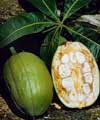 Malabar Chestnut
Malabar Chestnut
(Pachira insignis)
This small evergreen tree is grown in many parts of the world. It is grown mainly for its delicious seeds however it also makes a suitable potted indoor plant or outdoor specimen. Overall, the tree is a handsome landscape addition.
A versatile tree, the seeds can be eaten either raw or roasted. When roasted or fried in oil they taste like chestnuts or cashews, raw they taste like peanuts and keep for months in a cool, dry place. They can also be ground and used as a flour substitute when baking bread. The young leaves and flowers are cooked and delicious eaten as a vegetable.
Production starts within a few years. The large, white, self-fertile flowers display spectacular clusters of 10cm cream-white stamens. The fruit is a woody green five-valved pod up to 30cm in length. The capsules that follow burst open when the seeds are ripe.
The plant grows well in mild inland parts and coastal areas. The plant will tolerate brief exposure to low temperatures but won't tolerate frost. A frost-free location with some protection from hot, drying winds is the best choice for the plant. It will take full sun to partial shade. Malabar chestnuts are not overly fussy about soil as long as it is well drained.
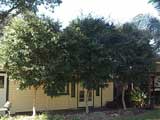 Jaboticaba (Myrciara caufiflora)
Jaboticaba (Myrciara caufiflora)
Jaboticabas are just one of the versatile, unusual and ornamental fruiting trees that have many uses in the garden. Pictured left are three jaboticabas used as shade trees on the hot western side of a home. They have been pruned from the base to give them the appearance of ball shaped specimen trees rather than their natural bushy shrub shape. The effect is wonderful, with the trees looking very similar to leopard trees but with the added bonus of an abundance of fresh fruit over the summer months.
The 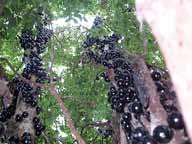 jaboticaba's habit of producing the fruit directly on the trunk makes it a striking tree. The black fruit has an edible thin, but tough skin. The texture is similar to a grape with a sweet and aromatic flavour.
jaboticaba's habit of producing the fruit directly on the trunk makes it a striking tree. The black fruit has an edible thin, but tough skin. The texture is similar to a grape with a sweet and aromatic flavour.
They look great in a tropical fruiting garden and the decorative coppery foliage adds a good contrast when they are planted as a hedge. They are mostly grown in the tropics or subtropics but can be grown in cooler, frost-free coastal areas.
For more information on the jaboticaba and the different varieties available please visit the catalogue.
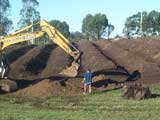 Nursery happenings
Nursery happenings
While many of our plants are sleeping during the winter we take the opportunity to complete major projects prior to the traditional spring rush. This year our project was to prepare an area of approximately 1 acre to be used as an orchard. Up to 300 trees were planted, and these trees will be used as a source of 'mother stock' and seed for future propagation needs.
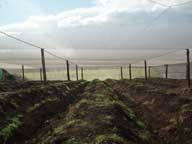 The first stage of the process was to have a backhoe operator and machinery mound the soil to ensure excellent drainage. The mounds were prepared in such a way that the poorer gravel-type soil remained on the bottom with the more fertile rich soil on the top. Prior to mounding our top soil was around 30cm deep and a small area of the orchard was prone to flooding.
The first stage of the process was to have a backhoe operator and machinery mound the soil to ensure excellent drainage. The mounds were prepared in such a way that the poorer gravel-type soil remained on the bottom with the more fertile rich soil on the top. Prior to mounding our top soil was around 30cm deep and a small area of the orchard was prone to flooding.
The second stage was to enclose the area with hail netting. This has the added benefit of protecting the fruit from birds and flying foxes. We have a large open area to allow machinery in and this also doubles as a thoroughfare for bees so that we are guaranteed a high level of pollination.
Although in the subtropical range of Australia, Kyogle is also described as 'warm temperate'. We are situated in a -5 degrees frost area with warm humid summers. The next step was to install irrigation. This irrigation includes a frost control system that will automatically come on when the temperature drops to 0 degrees. This system has allowed us to plant many of the warmer and frost senstive species.
The entire project, apart from supplying some of our future propagation material, will also be an experiment in which varieties of tropical fruits can be successfully and productively grown in a frost controlled area.
Included in the planting are tropical varieties of Star apples, Jakfruits and Abius. Our long term goal is to produce more cold tolerant varieties of trees suitable for planting in the cooler subtropical and warm temperate areas. For those of you in our warmer subtropical climates that often phone to plead for low chill varieties of cherries, almonds and medlars, we've included them also.
One thing we can be sure of is that as plants continue to grow so does the list of new varieties.
 The pitaya - Dragon Fruit
The pitaya - Dragon Fruit
Click to find out more about the Dragon Fruit (Pitaya)
In the July Newsletter we wrote an article on the virtues of the Pitaya or Dragon Fruit. Thank you for your response to the article. We've sent out quite a few of the plants probably due to their spectacular appearance as much as for the taste. Its also one of the few fruiting plants that will literally grow in a desert.
To follow up from the article and as a word of advice to all of you who have planted the pitaya, when you see your first fruit and are about to harvest, don't bother unless you have a sharp pair of secateurs with you. These are hardy plants, desert plants used to extremes and obviously one of their survival mechanisms is not to let go of their fruit too easily. And be aware that unlike the red skinned pitaya, the spines on the yellow variety do Spike!!!
 The taste of the yellow fruit is sweeter and of more substance than the red fruit/white flesh variety. To eat the texture was very much the same as a kiwifruit. All of us liked the fruit and would gladly eat it again which is always a good sign as we have very different taste buds.
The taste of the yellow fruit is sweeter and of more substance than the red fruit/white flesh variety. To eat the texture was very much the same as a kiwifruit. All of us liked the fruit and would gladly eat it again which is always a good sign as we have very different taste buds.
Recommended Links
We would like to share an excellent website with you. This site is the home of the Qld Department of Primary Industries and is great for home and commercial orchardists alike with many links to well recognised information sources.
Recommended Retailers
We have updated our list of recommended retailers to include those who are online. Also included are some new nurseries including David's Garden Centre in WA which is good news for the loads of gardeners who have requested plants in that neck of the woods.
To purchase plants (less than our mail order minimum) or for planting information, one of our recommended nurserymen in your locality will only be to happy to help.
To post your message please Contact Us





